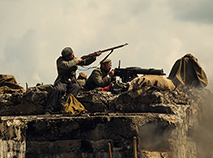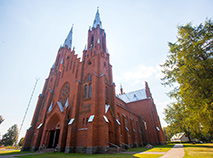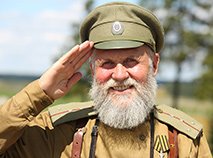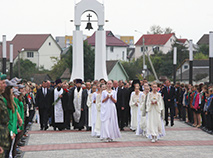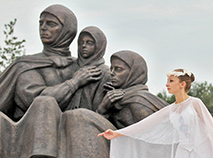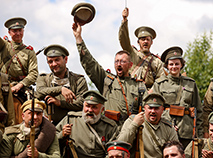World War I in Belarus
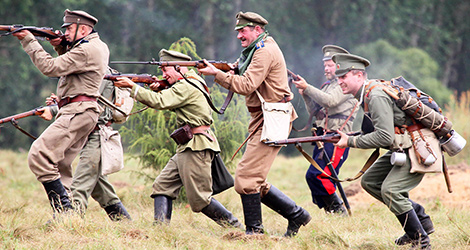
Battle reenactment timed to the 100th anniversary of the start of the First World War, Smorgon, 2014
The Great War involved 38 of the then 59 states of the world and was a big tragedy for Belarus. For three years, the Belarusian land was in the epicenter of military and political events, the site of fierce battles, it suffered huge losses, both human and material.
The first battles took place at the Grodno Fortress in August 1915. In September, after the bloody Sventsyany breakthrough, German troops finally entered the territory of Belarus, a part of the Russian Empire then.
For many years, the Western Front ran through the Belarusian towns of Postavy, Myadel, Vileika, Smorgon, Baranovichi, and Pinsk. By the end of the war, the enemy made temporary advancements to the line Rossony - Polotsk - Senno - Orsha - Mogilev - Zhlobin.
Belarus was the venue of major battles and military campaigns that claimed hundreds of thousands of lives:
-
battles at the Grodno Fortress (autumn – winter 1915)
-
Naroch Offensive (March 1916)
Thousands of soldiers were killed near Lake Naroch and its vicinities when Russian troops launched an offensive operation in March 1916, ahead of schedule, to ‘save France at Verdun’.
-
Baranovichi Operation (June – July 1916)
Baranovichi became the first city of the Russian Empire to unveil a monument to the heroes of the First World War. This happened on 8 June 1915. The city also housed the Stavka of the Supreme Commander-in-Chief, which was later moved to Mogilev, away from the front line.
-
defense of Smorgon (the town held ground for 810 days!)
-
large-scale battles near Smorgon and Krevo (summer 1917)
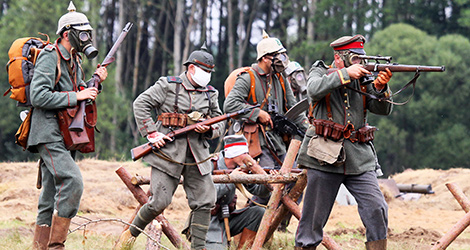
Battle reenactment timed to the 100th anniversary of the start of the First World War, Smorgon, 2014
During the First World War, the Belarusian land suffered huge losses: the territory was divided along the front line, people fled the war, enterprises and institutions that the authorities could not evacuate were destroyed by the enemy. More than 800,000 Belarusians were mobilized into the army. About every eighth person died... About 1.5 million residents became refugees. In peacetime more than 400,000 of them never returned home.
The year 1917 was a turning point for the Russian state. In the wake of the acute political crisis, military losses, devastation and famine, the February Revolution, the Civil War, the October Revolution, Russia started separate negotiations with the Austro-German Alliance. On 4 December 1917, the Armistice Treaty on the Western Front was signed in the village of Soly (now - Smorgon District, Grodno Oblast). Hostilities were suspended for two months, the general truce was concluded in Brest-Litovsk on 15 December 1917.
Nevertheless, after the armistice expired in February 1918, German troops, together with the Allies, relaunched an offensive on all fronts. In the Belarusian lands, they advanced to the line Rossony - Polotsk - Senno - Orsha - Mogilev - Zhlobin - Gomel. Only the eastern districts of Vitebsk and Mogilev provinces remained unoccupied.
In the difficult situation, the Soviet government signed the Treaty of Brest-Litovsk on 3 March 1918 on the terms of the German-Austrian Alliance. According to it, Russia ceded to Germany a territory of 780,000 square kilometers with a population of 56 million people - the lands of modern Poland, Estonia, Latvia, Lithuania, most of Grodno Oblast of today’s Belarus.
After the defeat of German troops in Western Europe and the November Revolution of 1918 in Germany, the Treaty of Brest-Litovsk was annulled by the Soviet government.
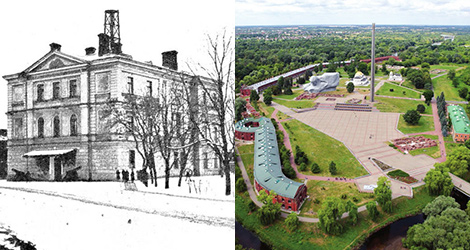
The ruins of the former White Palace where the Treaty of Brest-Litovsk was signed in 1918 can be found on the territory of the Brest Fortress
The events of the First World War in Belarus have not been studied on the scale as those of the Great Patriotic War. Much is yet to be explored. But there is no doubt that the Belarusian land became the scene of bloody battles and, in general, a long grueling trench war, suffered destruction and losses. It also saw the true heroism of soldiers, officers and civilians. During the First World War, more than 1 million soldiers of the Russian army were awarded The George Crosses and medals, including many thousands of natives of Belarus.
Today, the memory of the war lives in the memorials and museum expositions in the places that were once on the front line and are associated with the largest events that are now part of the world history.
In 1916-1917, when the both sides began to reinforce their defensive positions, thousands of structures were built on the territory of Belarus: firing points, shelters, observation posts, trenches, artillery caponiers, as well as auxiliary infrastructure. German-Austrian engineers set up fortifications mainly of concrete and steel, Russians - of earth and wood. To date, they survive in varying conditions: from dilapidated to well preserved, while remaining the largest monument in the history of the First World War.
Memorial complex to WW1 heroes and victims in Smorgon
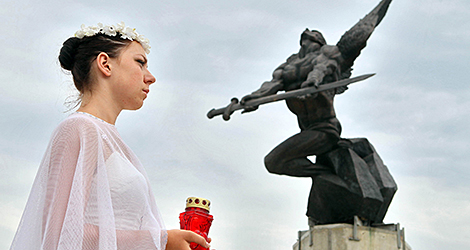
The town of Smorgon has Belarus’ largest memorial to the heroes and victims of the First World War. It was built on the site of real events, becoming the first complex of such scale.
The choice of place is symbolic: the town stood on the front line for more than two years - from September 1915 to February 1918. The town, which held ground for 810 days, was practically wiped off the face of the earth. Thousands died in the bloody battles for Smorgon. For example, just on one day of 25 September 1915, 3,500 Russian soldiers and about 5,500 Germans were killed here. After the war, the destroyed and scorched Smorgon began to be called a "dead town" as only about 150 inhabitants out of the pre-war 16,000 returned here.
A memorial complex was opened on 1 August 2014 in the memorable year of the 100th anniversary of the beginning of the First World War. It combines the sculptural compositions "Winged Genius of Military Glory", "Soldiers of the First World War" and "Refugees". There is also a chapel and a "Stone of Memory" with an address to descendants. A little further from the entrance, marked by The George Cross, there is a zone of memory and sorrow: a bronze map of military events of 1915-1917, two memorial urns with soil from the burial places of soldiers of the Russian and German armies, a chapel with a bell that tolls in memory of the soldiers of that war.
The movie "The Battalion” released in 2015 narrates about the tragic events on the front near Belarus’ Smorgon. It tells about the famous women's Death Battalion under the command of the legendary female officer Maria Bochkareva. It consisted of representatives of all walks of life: cadets, teachers, workers and peasants, Cossacks and soldiers, and women from the most noble families of the empire.
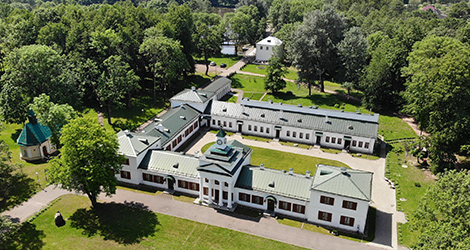 During the war, a large hospital was set up on the grounds of the former estate of Michal Kleofas Oginski in Zalesye, not far from Smorgon. It was run by the daughter of the great Russian writer Leo Tolstoy, Countess Alexandra Tolstaya. She wrote down her emotional reminiscences about the First World War, including about the terrible battles near Smorgon and the painful death of people from suffocation after gas attacks. The manor house where Oginski once lived and worked, was the headquarters of the 8th Siberian Infantry Division... Near Zalesye, there are several well-preserved mass graves and burials with tombstones to war heroes: sister of mercy Olga Mityukevich, who died from the explosion of a German bomb, Colonel Akaki Otkhmezuri, who took off his gas mask during a gas attack so that the soldiers could hear his commands…
During the war, a large hospital was set up on the grounds of the former estate of Michal Kleofas Oginski in Zalesye, not far from Smorgon. It was run by the daughter of the great Russian writer Leo Tolstoy, Countess Alexandra Tolstaya. She wrote down her emotional reminiscences about the First World War, including about the terrible battles near Smorgon and the painful death of people from suffocation after gas attacks. The manor house where Oginski once lived and worked, was the headquarters of the 8th Siberian Infantry Division... Near Zalesye, there are several well-preserved mass graves and burials with tombstones to war heroes: sister of mercy Olga Mityukevich, who died from the explosion of a German bomb, Colonel Akaki Otkhmezuri, who took off his gas mask during a gas attack so that the soldiers could hear his commands…
Where: Zalesye village, Smorgon District, Grodno Oblast
Krevo Castle
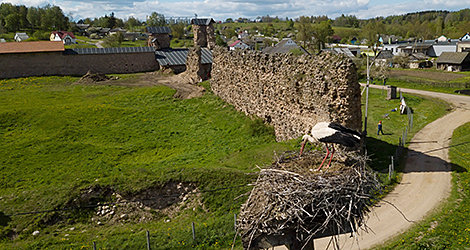
The village of Krevo is famous for the ruins of the famous castle built in the early 14th century. It is not only one of the oldest castles in the Belarusian lands, but also the first one completely built of stone. Once its walls were 2.5 meters thick and 12-13 meters high with two watchtowers in the corners ... As time passed by, the castle gradually fell into decay, and the First World War delivered a final blow to the castle.
In 1915, the Germans occupied the village of Krevo. Observation posts and shelters were built at the walls and in the inner courtyard of the castle, and a concrete pillbox was installed on the small tower.
In the summer of 1917, Krevo Castle experienced a heavy artillery shelling, one of the strongest in the history of the war. During an offensive, the Russian troops used almost 900 guns of various calibers, pouring fire on German positions near the castle. This caused massive damage, reducing the ancient walls to rubble. At present, work is underway to restore the castle.
Where: Krevo village, Smorgon District, Grodno Oblast
WWI Museum and memorial graves in Zabrodye
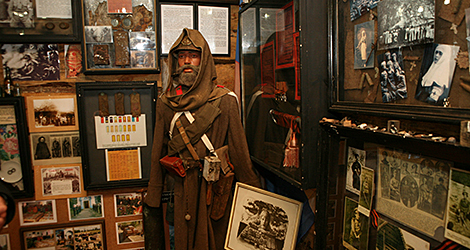
In 1916, one of the most fierce battles of the First World War took place in the area of Lake Naroch in the north-west of contemporary Belarus. More than 78,000 Russian soldiers and officers were killed and wounded there. Many died in the infirmary of the infantry division located near the village of Zabrodye (now Vileika District, Minsk Oblast).
More than half a century later, in 1974, the well-known Belarusian graphic artist Boris Tsitovich settled in Zabrodye with his family. He embarked on studying these places and memorializing their heritage. Thanks to the Tsitovich family, a small village turned into a place where you can travel in time through several eras at once. Visitors to the place can see an exposition about the First World War, a collection of retro cars, an exposition of the USSR and a collection of items of traditional Belarusian lifestyle. The estate runs master classes, ethnographic evenings and literary programs, as well as festivals dedicated to the Victory in the Great Patriotic War on 9 May and events commemorating the end of the First World War on 11 November.
By and large, the exposition in Zabrodye can be regarded as the first museum of the First World War in Belarus. After Boris Tsitovich came across mass graves in the forest in the 1970s, he embarked on a serious research of this historical period. Today, the memorial near the village of Zabrodye encompasses three mass graves and several single burials, memorial stones, a park in honor of fellow villagers.
In 1990, Boris Tsitovich, assisted by friends and soldiers of the Smorgon garrison, installed a concrete cross in memory of the fallen. In 2004, after receiving the Spiritual Revival Award, he spent all the funds he got from sponsors to create another memorial. A chapel was erected in Zabrodye in honor of the first Russian saints Boris and Gleb. The church was consecrated by Metropolitan Filaret of Minsk and Slutsk, Patriarchal Exarch of All Belarus. He also blessed the construction of a belfry nearby. The chapel accommodates this small but very informative museum.
Where: Zabrodye, Naroch rural council, Vileika District, Minsk Oblast
GPS coordinates: 54.543246, 26.728252
WWI museum exposition in Postavy
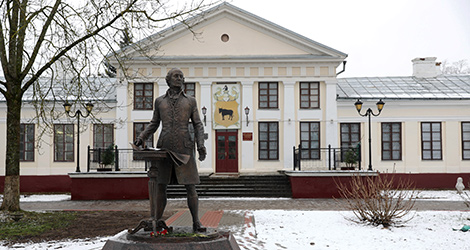 The town of Postavy was on the front line for almost three years. A museum exposition about the First World War opened in the cellars of the ancient Tyzengauz Palace. The collection was divided into four thematic groups: the History of WWI, Russian Trenches, German Trenches, Life and Death. Here you can see fragments of the original German barbed wire with wooden poles, as well as shells, a bottle of liquid for cleaning gas masks, the things soldiers used in the trenches. It is noteworthy that helmets and armored shields were found in German fortifications in the vicinity of Postavy.
The town of Postavy was on the front line for almost three years. A museum exposition about the First World War opened in the cellars of the ancient Tyzengauz Palace. The collection was divided into four thematic groups: the History of WWI, Russian Trenches, German Trenches, Life and Death. Here you can see fragments of the original German barbed wire with wooden poles, as well as shells, a bottle of liquid for cleaning gas masks, the things soldiers used in the trenches. It is noteworthy that helmets and armored shields were found in German fortifications in the vicinity of Postavy.
The museum exposition gives a glimpse into the life of people under occupation. Among the exhibits are passports that were issued by the German authorities to local residents. In addition to personal information and photos these passports included fingerprints. Among the documents on display are requests submitted by German soldiers to their commanders to allow them to marry local girls. The exposition also features a variety of things that German soldiers left behind - a speed skate, cheese packaging, beer bottles, boxes of sweets, cigarettes, cans…
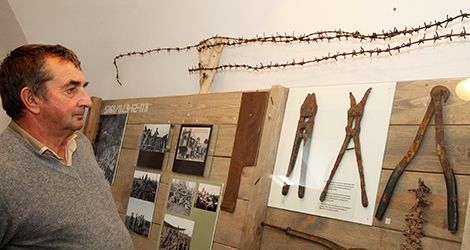 Where: 75 Sovetskaya Street, Postavy, Vitebsk Oblast
Where: 75 Sovetskaya Street, Postavy, Vitebsk Oblast
Church of the Nativity of the Virgin Mary in Vidzy
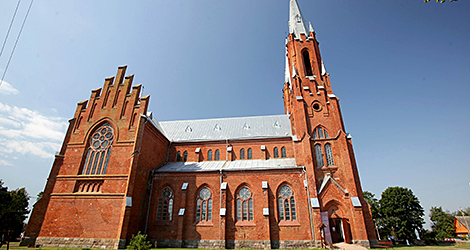
This majestic temple in the lake region in the north of Belarus was actively involved in the First World War. The construction of the Church of the Holy Trinity (today the Nativity of the Virgin Mary) in the town of Vidzy was completed in 1914. Back then, it was one of the highest structures in the Belarusian lands - the temple towers rose more than 70 meters above the ground. It is interesting that even today this church is one of the three highest Catholic churches in the country.
In 1915, the church was turned into ... an observation post of the German troops. It was a perfect place to watch the movements of the Russians and correct the artillery fire. In the first days of March 1916, just before the start of the famous Lake Naroch Offensive, the Russian troops fired at the church in order to deprive the Germans of the opportunity to see them. The church building was badly damaged: the towers were practically destroyed, the roof, walls and windows were damaged. It was not until 1932 that the temple was restored through the efforts of parishioners. Several Russian artillery shells were embedded in its walls in memory of those events.
In addition to that, concrete observation posts of the German-Austrian army can be found not far from the village on the shore of Lake Vidzy.
Where: Agro-town of Vidzy, Braslav District, Vitebsk Oblast
Forts of the Grodno Fortress
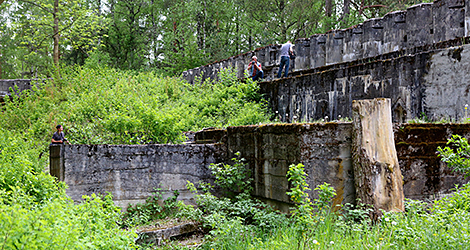
Grodno is located on the western border of contemporary Belarus. It had defensive fortifications because of its strategic location. After the Third Partition of the Polish–Lithuanian Commonwealth in 1795, its strategic role increased as it became an important outpost on the western border of the Russian Empire. At the turn of the 18th-19th centuries new fortifications were to be built around the town, but due to lack of resources and competencies, these plans were postponed. The construction began in 1887-1889, but the forts on the banks of the Neman River were built on the ground and, in fact, could hardly protect the town, especially from heavy artillery.
In August 1912, Nicholas II signed a decree to build a new fortress around Grodno. The construction works were to be completed in 1917. The project included 13 main and 19 auxiliary forts, 23 small strongholds. Concrete, metal elements, fortified shelters, galleries and underground passages, armored observation towers, lighting and ventilation, and even elevators for supplying ammunition - this was exactly what the last fortress in imperial Russia was supposed to have. But World War I thwarted the plans.
By the summer of 1915, not a single fort was fully completed - the builders managed to erect only concrete parapets and shelter galleries under the parapet. In August the fortress was abandoned: the weapons were taken out, the fortifications were blown up. However, the remaining forts, especially forts IV and III, were involved in fierce battles with the German army.
The most famous and best-preserved part of the Grodno Fortress, Fort IV, faced the attack on 31 August-1 September 1915. Its garrison had only two machine guns, which could not protect against heavy losses. Only 30 combat-ready soldiers left there by the evening. Retreating, the soldiers should have blown up the fort, but could not do this because of a large number of wounded in the shelter. This how the structure survived to this day. Even the armored observation post remained intact... In the Soviet times, this fort was used by border troops for some time. Today there are plans to set up a museum here.
Fort III with the longest fortification parapet (150 meters) also saw its biggest battle on 1 September 1915. The fort defenders had no response to the enemy's artillery fire as they had only a few guns following the evacuation. On the night of 2 September, the garrison left the fort, blowing it up.
Fort I was severely damaged as a result of the Russian army retreat in September 1915. Decades later, in the summer of 1944, Soviet soldiers defended it for several days. Fort II was blown up inside, but the parapet remained virtually unharmed. During World War II the Nazis used it as a place to execute local residents and prisoners of war… Over more than a century half-ruined Fort VII has turned into a kind of cave. Almost completely destroyed Fort VIII is covered with moss today. Fort IX, located a little further in the woods, has also almost merged with nature.
Where: Grodno District, Grodno Oblast
Historical and Memorial Museum “Nemtsevichi Estate” in the village of Skoki
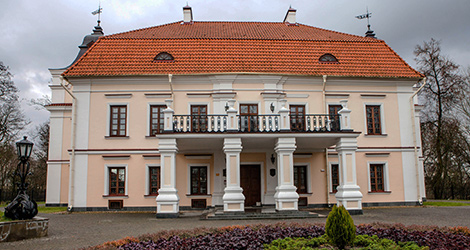 On the outskirts of modern Brest there is the village of Skoki with its main attraction - the former residence of the Nemtsevichi family, built in 1767-1777. During the First World War the estate witnessed events of epochal importance.
On the outskirts of modern Brest there is the village of Skoki with its main attraction - the former residence of the Nemtsevichi family, built in 1767-1777. During the First World War the estate witnessed events of epochal importance.
When Nicholas II announced the evacuation and ordered to destroy all the houses so as not to leave them to the enemy, the owners did not leave their ancestral home till the last moment. The wife of Yan Nemtsevich - Sofia - took the word from a Cossack officer that the estate would not be blown up. And the mansion survived. Later it was the headquarters of commander of the Eastern German Front, Prince Leopold of Bavaria for almost two years. It was here, on 15 December 1917, that representatives of Germany and its allies on one side and Bolshevik Russia on the other signed a military truce that ended hostilities from the Baltic Sea to the Black Sea and in Asia. Two days later there was the first organizational meeting to negotiate a peace, which was eventually signed in the White Palace of the Brest Fortress on 3 March 1918.
In the hungry post-war years, the Nemtsevichi family helped the locals, organized free meals for children, invited them over to the estate park for big celebrations, and gave them gifts. In 1935, they left the family estate forever.
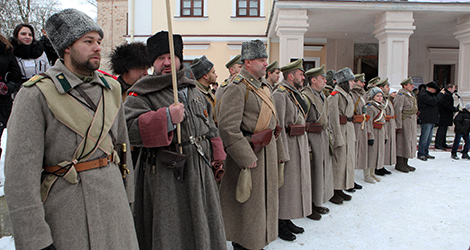 Nowadays, visitors to the estate can learn a lot about its past. The place also hosts the international military and historical festival Skoki that is dedicated to the events of World War I. Traditionally, the festival is held in December: the organizers inform about the dates and the program in advance.
Nowadays, visitors to the estate can learn a lot about its past. The place also hosts the international military and historical festival Skoki that is dedicated to the events of World War I. Traditionally, the festival is held in December: the organizers inform about the dates and the program in advance.
Where: village of Skoki, Brest District, Brest Oblast
Military cemetery in Minsk

The military cemetery of 1914-1918 in the Belarusian capital of Minsk contains the remains of more than 5,000 soldiers who died in local hospitals.
In 1914, the war had not yet reached the Belarusian lands, but the wounded had already begun to be brought from the fronts. About 15 hospitals were set up in Minsk, where the wounded were treated and operated, but not all of them survived. The city council bought a land plot from the Minsk cathedral between Starovilensky and Dolginovsky highways. A large cemetery was set up on the area of two hectares as a symbol of brotherhood of soldiers. Christians were buried on one half of it, and representatives of other religions on the other.
During the war some 5,000 soldiers were buried here. The names of 2,468 of them were known from the lists in the Russian State Military History Archive in Moscow. A wooden chapel was also set up there: Empress Alexandra Feodorovna donated money and asked to make the inscription “To the Heroes of the Great European War”. In 1915 refugees were housed on the vacant part of the land plot. The Storozhevsky market was set up to provide people with staples. Next to the military cemetery the city set up a cemetery for refugees who were dying of diseases and deprivation.
Unfortunately, after the revolution the graves were forgotten, and were destroyed in the late 1940s. During the Great Patriotic War, the Nazis set up a concentration camp on the territory of the refugees cemetery and the marketplace. Thousands of people were killed there.
In 1996, the Belarusian Voluntary Society for the Protection of Monuments of History and Culture put forward an idea to perpetuate the cemetery site. The idea was supported by the press, the church, and the state. The memorial was opened in August 2011.
The cemetery is framed by dark marble fence, decorated with forging and shields with images of orders of the Russian Empire. The arch above the central entrance symbolizes the Intercession of the Blessed Virgin Mary. Marble slabs immortalize the names of fallen soldiers with the inscription of their military units. In the center there is a stone chapel built at the site of its wooden predecessor. It was consecrated in honor of the Icon of the Mother of God The Sign, which was depicted on the military banner and was the patroness of soldiers. Outside the chapel is decorated with bronze bas-reliefs of saint warriors Alexander Nevsky, Dmitry Donskoy, John the Warrior, and Archangel Michael. At a depth of 3 meters there is a crypt which keeps the found remains.
Where: Starovilensky Trakt Street-Chervyakova Street-Khoruzhei Street, Minsk
Belarusian regions offer tourist routes to the places of battles and memorable events of the First World War:
-
The Augustow Canal during the First and Second World Wars
-
Under the cross of St. George: The roads of World War I
-
World War I through the eyes of descendants (Zalesye)
-
World War I in Polesye
-
The Road of Memory reenactment (along the fortifications of the Grodno Fortress)
-
On the Waves of Time (along the places of World War I battles)
-
World War I in Vileika District and the town of Vileika







 print version
print version make home page
make home page add to bookmarks
add to bookmarks